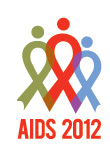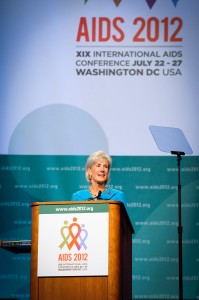 Kathleen Sebelius, the Department of Health and Human Services Secretary, officially welcomed delegates to the XIX International AIDS Conference (AIDS 2012) with messages of encouragement and by introducing a series of public-private partnerships to help end the AIDS epidemic in the United States.
Kathleen Sebelius, the Department of Health and Human Services Secretary, officially welcomed delegates to the XIX International AIDS Conference (AIDS 2012) with messages of encouragement and by introducing a series of public-private partnerships to help end the AIDS epidemic in the United States.
“In the United States, infections among injection drug users have dropped more than 80 percent,” she said. “Pediatric cases of HIV are down more than 90 percent. And the last time this conference was held on American soil, there was no effective treatment for HIV. Today, someone diagnosed with HIV and treated before the disease is far advanced can have a nearly normal life expectancy.
“Around the world, new infections are falling. The ranks of those on treatment are growing. In countries where AIDS has taken its greatest toll, life expectancies are beginning to rise once again.
"As a result,” she continued, “we’ve reached a point where the goal of an AIDS-free world, once a far-off dream, is now within sight.”
But now is not the time for “easing up, slowing down, or shifting our focus,” she said. There is still a tremendous amount of work left to be done locally—one in every 16 black men living in Washington, DC, is living with HIV—as well as nationally, where the new infection rate has stopped falling and is actually rising among young gay and bisexual men, and globally, where millions who need antiretroviral (ARV) therapy still aren’t getting it.
 | |
| Kathleen Sebelius, Health and Human Services Secretary, addressing approximately 21,000 delegates at the AIDS 2012 opening ceremony. |
Focusing primarily on the fight in the United States, Sebelius noted that the National HIV/AIDS Strategy unveiled two years ago “has given a new sense of direction and purpose to our domestic response.”
It starts with more funding, she explained. “For roughly a decade before the President came into office, domestic HIV prevention funding had been flat. Since President Obama has come into office, resources have increased every year. And on Thursday, we announced nearly $80 million for HIV/AIDS treatment, which will expand care for 14,000 new patients, and which states say will allow them to fully clear their ADAP waiting lists.”
The new strategy is also allowing the government to target resources more effectively to the communities that have been hardest hit, she said. “Already, we’ve made key changes in how we distribute funds to health departments for prevention, moving to a new formula that better reflects the needs of today. And we’re focusing on the interventions that have been proven to work best, including testing, linkage to care and treatment.
"And I’m proud to say that today, Americans have better access to these life-saving interventions than ever before. Thanks to the historic health care legislation signed by President Obama, America is on its way to joining the rest of the industrialized world in making affordable health coverage available to all our citizens. And we’re outlawing the worst abuses of an insurance industry that often sought to lock people with HIV/AIDS out of the market, cap their share, or cancel their coverage without cause.”
The Obama administration also has its eyes focused forward, with a handful of initiatives designed to foster collaboration between the public and private sectors to advance progress where it is needed.
“This evening,” Sebelius said, “I’m proud to announce four public-private collaborations that will make it easier for Americans to get HIV care.”
First—and greatly welcomed by many HIV treatment activists, providers and other direct-service providers throughout the country—is the long-awaited creation and release of a single application form for ARVs offered through patient assistance programs. According to Sebelius, all pharmaceutical companies manufacturing ARVs will begin accepting the common form starting September 1, 2012.
This single common form will allow uninsured individuals living with HIV to apply for multiple assistance programs, providing coverage for an entire course of antiretroviral therapy regardless of manufacturer. By reducing barriers to medication access for those living with HIV, this streamlined process will encourage eligible patients to begin or continue their needed treatment.
DHHS is also working with Medscape, a provider of online continuing education for health care providers, to create new training programs to help them better understand and address the needs of people living with HIV.
The agency is launching two partnerships with the MAC AIDS Fund: a mobile texting pilot program called UCARE4LIFE to help people living with HIV receive important reminders and tips for managing their disease, and a joint project with PEPFAR that will bring together international leaders to explore how lessons learned through PEPFAR can be applied to the U.S.
Finally, DHHS will partner with Walgreens to evaluate new collaborative agreements between health care providers and community pharmacists designed to deliver drug therapy management and other supportive services to improve retention in care, adherence to drug treatment regimens, and, ultimately, health outcomes among their HIV-infected patients.
“I want to thank all of these partners for stepping up,” Sebelius said. “And we will continue to seek out new public-private collaborations that will help us beat this disease.”






Comments
Comments